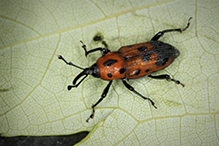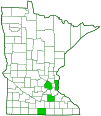Cocklebur weevil
(Rhodobaenus quinquepunctatus)
Conservation • Description • Habitat • Ecology • Distribution • Taxonomy
|
|
||||||||||||||
Description |
Cocklebur weevil is a medium-sized true weevil. It is widespread in the eastern half of the United States. The body is 3 ⁄16″ to 5 ⁄16″ long, elongated, and oval, more-or-less football-shaped. The thorax is composed of three segments. The first segment (prothorax) is large and prominent and appears to be the entire thorax. It is covered by a saddle-shaped plate (pronotum). The pronotum is slightly wider than long and is rounded at the sides. The pronotum is reddish-orange with five black spots: a single, oval, median spot; and two smaller spots on each side. There are two pairs of wings, a membranous inner pair and a hardened outer pair (elytra). The elytra are attached to the second thoracic segment (mesothorax). They cover almost but not quite all of the abdomen. They are wider than the pronotum, oblong egg-shaped, rounded at the tips, moderately convex, longitudinally grooved, and pitted. They are reddish-orange and each has five black spots. The median line where the elytra meet (elytral suture) is black. A large spot at the tip coalesces with one on the opposite elytra forming a single large spot. A smaller spot halfway between the base and the tip usually coalesces with one on the opposite elytra. A single lateral spot near the tip sometimes coalesces with the one at the tip. Two smaller lateral spots near the base are always separated. Rarely, almost the entire elytra will be black. The head is greatly elongated between the eyes and the mouth parts form a conspicuous snout. The snout is narrow, enlarged toward the tip, and very long, about as long as the prothorax. It is projected forward and bent downward. The antennae are short, slender, and elbowed. They have eleven segments. The last 3 segments are expanded and form a club. The antennae are inserted near the eyes. The legs are black. The last part of each leg (tarsus), corresponding to the foot, has five segments. The fourth segment is very short and is concealed within the broadened tip of the third segment, making the tarsus appear to have only four segments. |
Size |
Total length: 3 ⁄16″ to 5 ⁄16″ |
Similar Species |
Ironweed curculio (Rhodobaenus tredecimpunctatus) is larger, up to 7 ⁄16″ long. The median line where the elytra meet (elytral suture) is red. The black spots on the elytra are always separated. They do not coalesce to form patches. |
Habitat |
|
Ecology |
Season |
|
Behavior |
Larvae bore into the stems or roots of cocklebur and ragweed. |
Life Cycle |
|
Larva Hosts |
Stalks of all of the adult’s host plants |
Adult Food |
Stalks and leaves of cocklebur (Xanthium), ragweed (Ambrosia), thistle (Carduum), ironweed (vernonia), Joe Pye weed (Eutrochium), sunflower (Helianthus), marsh elder (Iva), and rosinweed (Silphium). |
Distribution |
||
|
Sources |
|
| 8/18/2025 | ||
Occurrence |
||
Widespread in eastern the United States |
||
Taxonomy |
|
Order |
Coleoptera (Beetles) |
Suborder |
Polyphaga (Water, Rove, Scarab, Long-horned, Leaf, and Snout Beetles) |
Infraorder |
Cucujiformia |
Superfamily |
Curculionoidea (snout and bark beetles) |
Family |
Curculionidae (true weevils) |
Subfamily |
Dryophthorinae |
Tribe |
Rhynchophorini |
Subtribe |
Sphenophorina |
Genus |
Rhodobaenus |
Subordinate Taxa |
|
|
|
Synonyms |
|
Rhodobaenus formosus Rhodobaenus triangularis |
|
Common Names |
|
cocklebur weevil |
|
Glossary
Elytra
The hardened or leathery forewings of beetles used to protect the fragile hindwings, which are used for flying. Singular: elytron.
Pronotum
The exoskeletal plate on the upper side of the first segment of the thorax of an insect.
Prothorax
The first (forward) segment of the thorax on an insect, bearing the first pair of legs but not wings.
Tarsus
On insects, the last two to five subdivisions of the leg, attached to the tibia; the foot. On spiders, the last segment of the leg. Plural: tarsi.
Visitor Photos |
||
Share your photo of this insect. |
||
This button not working for you? |
||
Alfredo Colon |
 |
Weevil From Woodbury, MN. Taken on June 8, 2018. |
MinnesotaSeasons.com Photos |
||
|
||
|
||

Slideshows |
|

Visitor Videos |
||
Share your video of this insect. |
||
This button not working for you? |
||
|
Other Videos |
||
Cocklebur Weevil (Rhodobaenus quinquepunctatus) - On A Mission |
About
Published on Jun 7, 2017 Cocklebur Weevil (Rhodobaenus quinquepunctatus) On A Mission |
Attack of the Killer Weevils!! What the damage looks like on sunflowers and how to kill them. |
About
Published on Jun 10, 2016 It seems like every year I run into a bug or two that I've never dealt with before. This year, it is a little red/orange weevil with black spots. The best I can tell, it is either a cocklebur weevil, or the ironweed curculio. They can really do damage to sunflowers. At first I thought that some broken leaves were due to some high winds that we had been having, but soon figured out it was the weevils. Subscribe at: https://www.youtube.com/user/WarLetters |

Created: 7/23/2018 Last Updated: © MinnesotaSeasons.com. All rights reserved. |


